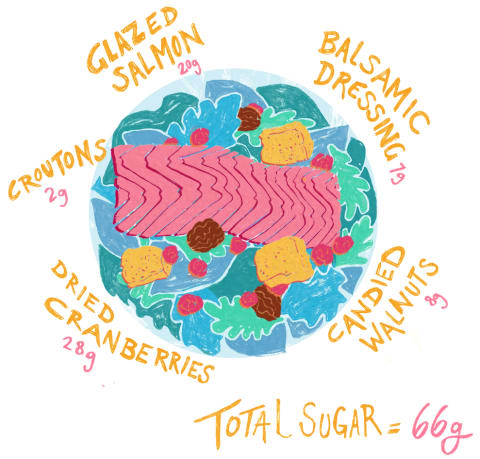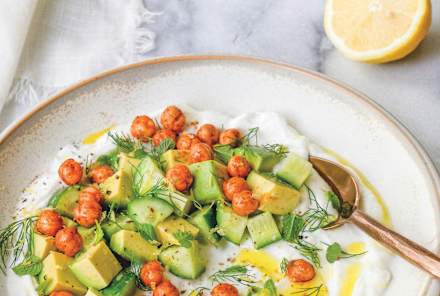Advertisement

Since 2014, Target’s Made To Matter program has highlighted brands with natural, organic, sustainable products. This year, the retailer is stepping it up a notch by challenging its partners to innovate across five key areas that impact the environment and the day-to-day lives of shoppers.
Today, we’re diving into the first category: reduced sugar. And we called on a leading voice in clean eating, Dana James, to help us unpack the complex issue.
By this point, everyone is familiar with the dangers of sugar. From diabetes to liver damage, too much of the sweet stuff can cause some serious health issues.
So why are Americans still eating an average of 153 grams (the equivalent of more than 6 chocolate bars) of it a day? Nobody knows better than nutritionist and founder of Food Coach NYC, Dana James.
"At one point in my life, my sugar cravings were so intense that I ate the sweet stuff directly from the packet and devoured cacao truffles every night for months on end. In what seemed like an out-of-body experience, my conscious mind felt like it was constantly overpowered by an extreme physical need for sugar," James explains.
It turns out that her cravings were the by-product of a candida overgrowth that was causing a microbial imbalance in her body. With the help of supplements and diet changes, James was able to overcome her sugar cravings and, as she puts it, get her sanity back.
"My mind finally stopped playing that tug-of-war game of yes/no/yes/why do you do that?" says James. "I’m fortunate that I was able to uncover my underlying candida. Many people live years and even decades believing that they are weak-willed or 'addicted' to sugar."
If you find yourself having trouble cutting back on sugar for any reason, bacteria related or not, here are a few of James’ pro tips to get your intake under control:
1. Write down everything you eat for a day. Highlight anywhere there's sugar in your diet and look at where you can easily cut it out. Five sugars in your morning coffee? Take it down to one. 3p.m. M&M’s? Replace them with an apple.
2. If you find it challenging to resist sugar after dinner, allow yourself something sweet that's under 100 calories but doesn’t contain sugar substitutes. (A Justin’s Peanut Butter cup or two squares of dark chocolate are both great options.)
3. Once you’ve mastered that, start reducing it from every night to every other night and find a fun replacement habit to keep your mind occupied. Read an engrossing book, watch something funny on YouTube, create Pinterest boards, hang out with friends, learn a language, meditate, or take some quiet time to reflect and dream.
4. Don’t beat yourself up if you eat more sugar than you'd like. Sugar can play an enjoyable role in our lives when it’s consumed on an irregular basis. After all, who doesn’t love a matcha green tea ice cream on a lazy summer afternoon?
5. Be sure to always check a product's label any time you're thinking of indulging. Sweeteners like rice syrup, corn syrup, coconut nectar, date paste, glucose, cane sugar, agave, honey and cane sugar are all are fine, but you should avoid the much-maligned high-fructose corn syrup (HFCS). Look at the labels on your savory products as well. If it contains one of these sweeteners, or anything ending in 'dextrin and ‘ose (like sucrose and maltodextrin), it has sugar. And if these pop up in its first three ingredients, it's really a sweet and not something savory.
6. Avoid unnecessary sugar by shopping on the perimeter of the grocery store. I love to navigate these aisles and fill my cart with produce, seafood, grass-fed meat and BPA-free canned foods like chickpeas as well as some seaweed crackers.
Now that you have a taste of Dana’s story, here are some mbg-approved resources to help you put her tips into practice. If nothing else, we hope that they help you assess your own relationship with sugar and learn to identify some healthier alternatives.
mbg Unpacks The Issue
Sugar Then & Now

In 1822, the average American consumed 9 grams of sugar every day. Today, that number is closer to 153 grams. That’s because many packaged foods are now full of sugar and eating the sweet stuff on a daily basis produces characteristics of craving and withdrawal, leaving us going back for seconds (and thirds, and fourths).
Where's It Hiding?

When you think about the fact that a lunchtime salad can hide this much sugar, it’s easy to see why our intake of the stuff is skyrocketing. Other seemingly healthy meals that could actually be hiding added sugar include flavored oatmeal (opt for unflavored and add fruit or nuts instead), grains with canned sauce (try your hand at making your own sauces), and granola bars (some of these can pack upwards of 40 percent of calories from sugar).
A Sweet Day



The FDA recommends that Americans consume no more than 50 grams of added sugar a day. Now, the fruit in your morning smoothie doesn’t count towards that number, but the sugar you’re throwing in for flavor does. So what does a day with less than 50 grams of added sugar actually look like? It features a whole lot of fruits and veggies, along with a few treats thrown in here and there.
The Natural Alternatives
Not all sweeteners are created equal. Here’s our take on which natural sources of sweetness are okay to enjoy in moderation:

- Agave: Agave nectar is a natural sweetener that has been shown to be a good source of iron and calcium.
- Honey: Raw honey is packed with vitamins, antioxidants and potassium. It also promotes healthy digestion.
- Molasses: Molasses contains antioxidants, and it’s even been shown to promote healthy skin and fight acne in some cases.
Made To Matter
Pair your morning cereal with this..

Ripple: Ripple is serving up dairy-free milk made from peas that’s high in protein but low in sugar. Peas’ inherently sweet flavor means that Ripple has half the sugar of daily milk and 15 percent less than dairy alternatives like nut, coconut and soy milk.
Time to pack lunch? Give your child one of these…

Clif Kid: Clif Z Bar’s latest creation is a fruit and veggie bar that has about half the sugar of a small box of raisins. Free of synthetic preservatives, the snack features bold fruit and veggie combos like carrot, mango and orange and sweet potato, beet and berry that are naturally low in sugar.

Why Nutrition Is Key To Changing Your Relationship With Alcohol
Brooke Scheller, DCN, CNS

Why Alcohol Sabotages Your Gut Health & How To Get Back On Track
Brooke Scheller, DCN, CNS

Why Nutrition Is Key To Changing Your Relationship With Alcohol
Brooke Scheller, DCN, CNS

Why Alcohol Sabotages Your Gut Health & How To Get Back On Track
Brooke Scheller, DCN, CNS

Why Nutrition Is Key To Changing Your Relationship With Alcohol
Brooke Scheller, DCN, CNS

Why Alcohol Sabotages Your Gut Health & How To Get Back On Track
Brooke Scheller, DCN, CNS

Why Nutrition Is Key To Changing Your Relationship With Alcohol
Brooke Scheller, DCN, CNS

Why Alcohol Sabotages Your Gut Health & How To Get Back On Track
Brooke Scheller, DCN, CNS















